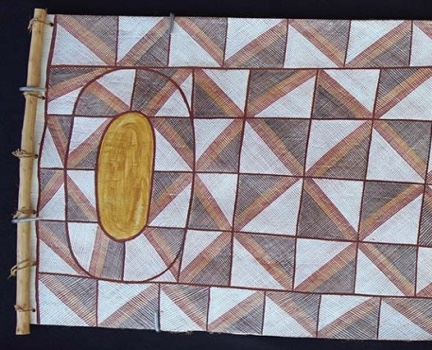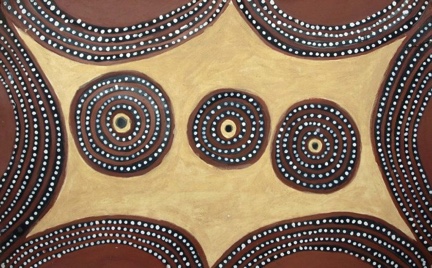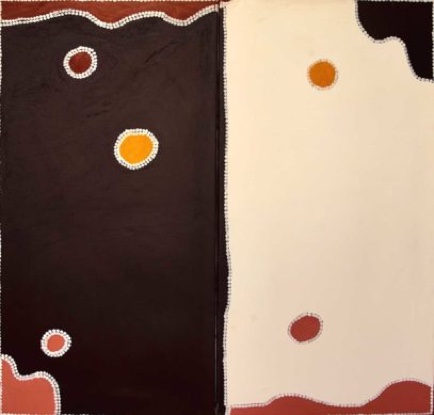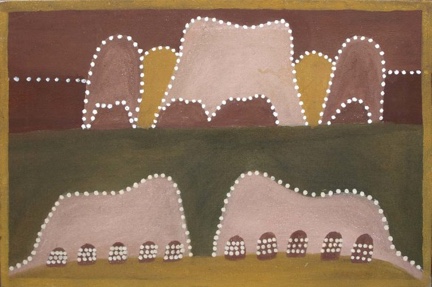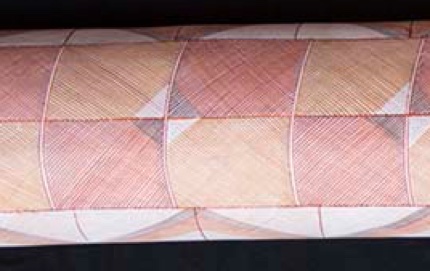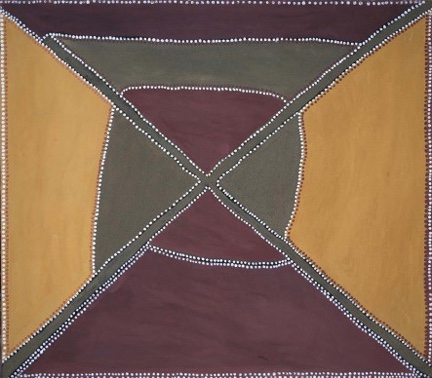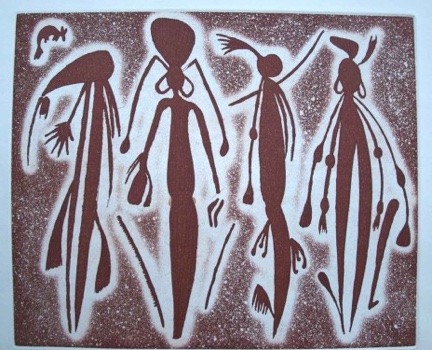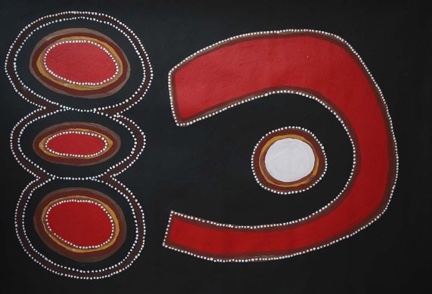Australian Aboriginal Ochre Painting
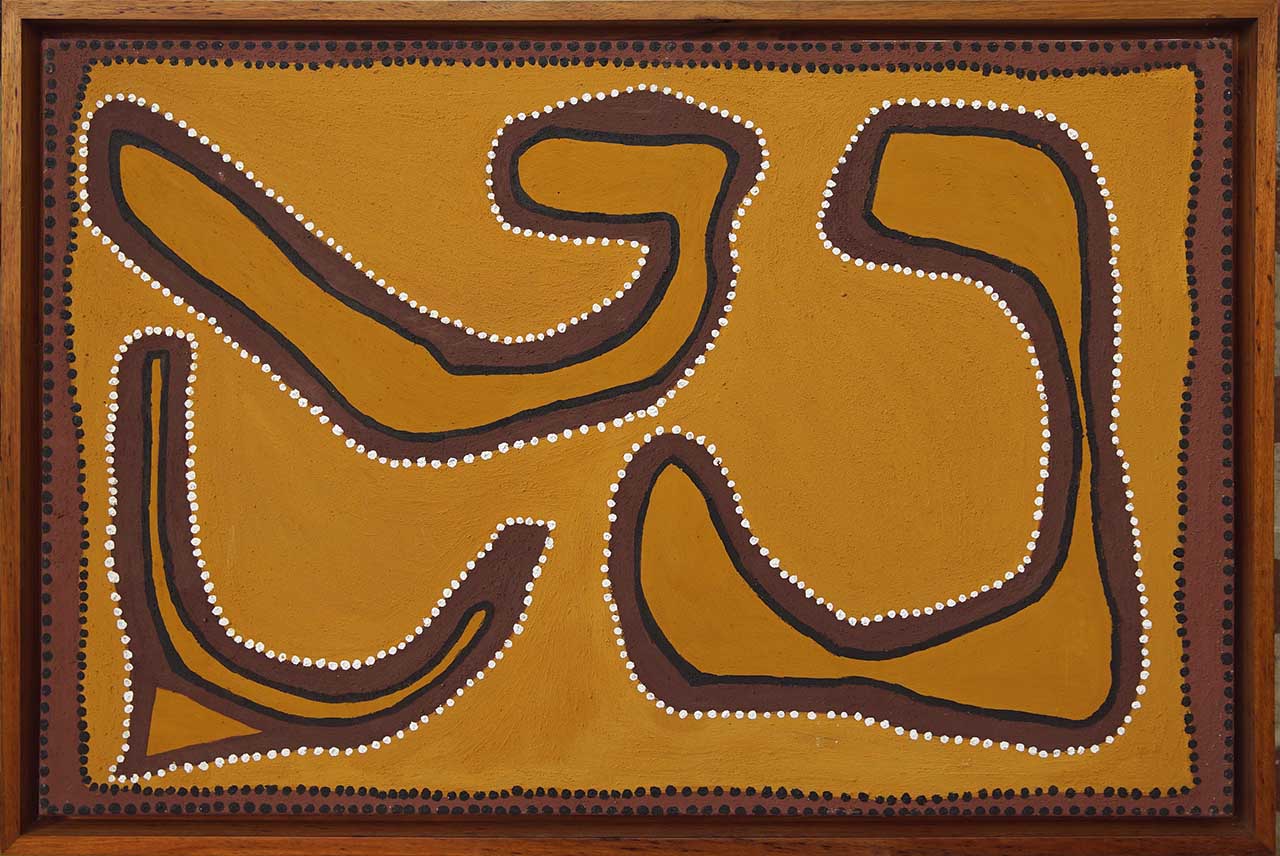
Ochre Is Used As a Foundation of Cultural Expression
Ochre is one of the principal foundations of Australian Indigenous art. Ochres are primarily natural pigments and minerals in the soil or charcoal. These natural pigments (colours) were originally used to depict Dreamtime stories and maps. They were used in body painting, rock painting, on artefacts and sometimes even sand.
Stories Communicated Visually
They were the first ways for the people of the oldest continuous culture (at least 65,000 years old) to tell their stories visually. Indigenous people never had a written language. They tell stories through either oral traditions such as stories and songs or symbols like concentric circles, U shapes and straight stick forms. These were all done using the natural pigments found and even specifically mined.
Ochre As A Traded Commodity
Originally, ochres had an enormous value. They were traded between different tribal groups across Australia. Trade routes, almost like the silk routes, went through Asia. However, in this case, the valuable products were natural ochre pigments instead of silk. Some were more highly prized than others. They had great value. Some places didn't have a lot of ochres, but they still had the same need to tell stories and record images of Dreamtime spirits. Sometimes, they gave warnings regarding hazards or instructions about how to find the nearest water hole or where there was good hunting for different types of animals and fish. However, the main use was storytelling and depicting important Spirits and totems. All of that message-making was enabled by using natural ochre pigments. Without that material, art would have been much more limited to scratchings in rocks and carvings. Many of the rock paintings still exist to this day.
Painting Easier Than Carving
Ochre was much easier to use as a medium. It was immediate and especially prized for body painting for big ceremonies, initiation ceremonies, or rain-related dances. The Seven Sisters stories were often represented by ochre pigments in women's body painting and men's paintings.
Ochre Offers A Limited Palette
Ochre had a few drawbacks as there were only about six available colours, even with blending and mixing, so it did limit the palette. In some ways, these palette restrictions produced a more rigorous and defined art form, and it taught people to consider the use of colour. If you only have a limited palette, it teaches you which colour to use next to another. That is how you learn what works. You've only got a limited number of options. The use of ochre carried on for tens of thousands of years. It defined Indigenous culture and character to the wider audience across Australia.
Acrylic Paint Becomes Available
The advent of the Indigenous Fine Art Movement around 1971 saw the introduction of acrylics or synthetic polymers. Suddenly, there was a rainbow of colours available to artists. Initially, many artists, like those in Papunya, embraced the use of acrylics because they were easier to use and available. They didn't have to mix them with a binder to affix them to a board, an artefact or the cave wall. They were just a lot simpler to use. Many artists stayed with the original palette even when using acrylics. This carried on for quite a few years.
Jimmy Pike Brings Vibrant Colours
It wasn't until artists like Walmajarri Jimmy Pike from the Kimberley came around in the 1980s that the use of colour shifted. He introduced extremely strong, vibrant acrylic and even texta colours into his paintings, which completely transformed the movement. There's a real dividing line that led to a transitional phase from ochre to acrylic in the Central and Western deserts. After that, there was a real flourish of colour across the whole movement. Artists were embracing colour and the different options it gave them. Many artists, even though they had often worked with a limited palette most of their lives, were brilliant colourists and natural at using colours. They showed great skill at putting colours together that you don't think would work together. Instinctively, they did, and they knew what they were doing.
Colour Brings International Attention
That vibrant use of colour underpinned the rebirth of the Indigenous Fine Art Movement to its recent peak in 2007, when it achieved worldwide success. It would not have had the same impact worldwide if it had just been limited to ochre. It's hard to know for certain, but I doubt if it would have.
Ochre is Still In Use
Paradoxically, several communities still use traditional ochre pigments in their paintings today. One of the main ones is Warmun Art Centre, which used to be called Turkey Creek up in the Kimberly. Some of the greats of the Indigenous Fine Art Movement came from using that ochre.
Ochre Artists Achieve Fame
As I mentioned before, that restraint engendered by using natural ochre pigments and the limited palette probably led to the genesis of one of the greatest artists, Rover Thomas Joolama, famous for his various spare paintings where less is more. He went on to achieve international success. I think it's partly through his use of the medium of natural ochre pigments that informed his storytelling and painting skills. Some of the other greats from the movement were Queenie McKenzie, Jack Britten, Hector Jandanay from that one community alone. They carried the banner for ochre pigment painting.
Ochre Use in Crosshatching
In the Northern Territory, specifically in the Arnhem Land and the Tiwi Islands, the adherence to natural ochre pigment continues. A lot of the artists in those communities use rarrk, which is a crosshatching format of painting using natural ochre pigments. In this crosshatching, each artist has their own identifying rarrk. They're all painted in the limited palette of natural ochre pigments. In Arnhem Land, they're still using ochre, and their works are very fine. They're also often figurative. Some also embrace the technique that is called X-ray style where you can see the internal workings of animals. They also use the ochres to paint totems, and statues and carvings, usually made out of the local ironwood, but also of other woods found up in the tropics. To this very day most of the art from those particular regions in the Northern Territory and Arnhem Land, is still painted in traditional ochre pigments. Even the body paintings still carry on the ancient traditions of using ochre pigments.
Ochre Still Used In Ceremony
This is also true of other communities that have embraced acrylics and synthetic polymers for their paintings. They've still retained the use of ochre pigments for their ceremonial dances and corroborees. Ochre still has a spiritual significance to Indigenous people and an ancient connection that goes back unbroken for tens of thousands of years. The use of ochre underpins, to a large extent, Indigenous art and culture from all around Australia.
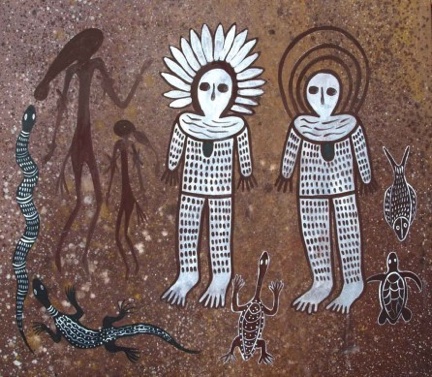
Donny Woolagoodja | Cyclone Wandjina
Related Articles
- Aboriginal Bark Paintings and Artefacts
- Art Centres in Arnhem Land
- Marcia Purdie & The Storytellers of Warmun
- Edward Blitner New Works – Rarrk Cross-hatching
- Tjunguṉutja – The Stunning Papunya Exhibition
- Kimberley Ochre Painters – The Old And New
- Paintings From The Earth – The Ochres From The Kimberley
- What My Father Jack Dale Taught Me
- Wandjinas, Ochre and The Art of Mowanjum People
- Science Uses Ochre To Map Ancient Aboriginal Trading Routes
- Ochre Collection
- Australian Aboriginal Ochre Painted Larrakitj Memorial Poles
- Restoration of Australian Aboriginal Ochre Paintings
- Rover Thomas Painting a Highlight at Japingka Gallery
Related Artists
- Jack Britten
- Edward Blitner
- Hamish Garrgarrku (Karrkarrhba)
- Lily Karadada
- Willie Kew
- Queenie McKenzie
- Jack Dale Mengenen
- June Peters
- Marcia Purdie
- Rover Thomas
- Freddie Timms
Related Exhibitions
- Made In Ochre – Kimberley Artists 2017
- Mowanjum – Paintings & Prints 2015
- Hamish Garrgarrku, Maningrida – Solo Exhibition 2015
- Kimberley Ochre Artists 2014
- Tiwi Carvings & Sculptures 2014
- Edward Blitner – Stories from my Grandfather 2012
- Mowanjum Artists – Paintings and Prints 2011
- Jack Dale Mengenen 2011
Related Links
- Australia’s Oldest Known Aboriginal Rock Paintings - University of Melbourne
- Making Ochre at Luyni Mungalina - This Place - YouTube ABC Indigenous
- Australian Body Painting - The University of Oxford
- First Rock Art - National Museum Australia
- Australian Indigenous Ochres: Use, Sourcing, and Exchange - In book: The Oxford Handbook of the Archaeology of Indigenous Australia and New Guinea
- Aboriginal ochre art under high-tech ‘hands-off’ focus to map culture trail - Australia's Nuclear Science and Technology Organisation, (ANSTO)
